You are visitor number ***ENJOY***

 **Please Be Kind To All Your Pets**
**Please Be Kind To All Your Pets**
 Torty  Sheltie 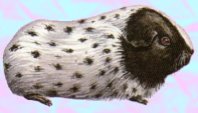 Dalmatian  Silver Agouti 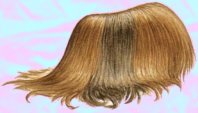 Peruvian 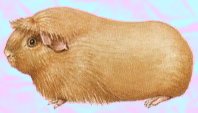 English Crested 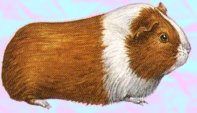 Dutch 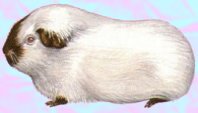 Himalayan 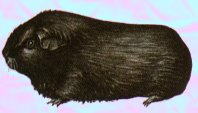 Self Black 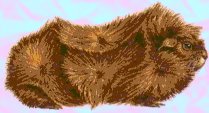 Abbyssinian 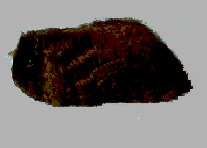 Texel 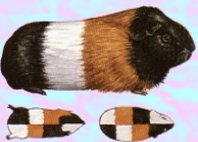 Trotoiseshell & White  Red 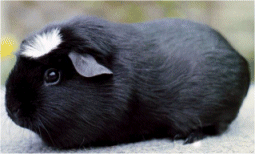 American Crested |

The list given below is not a
complete copy of the Standards.
Rather, a brief introduction to the different Breeds...
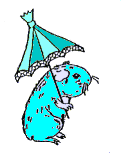 The Selfs
The Selfs
The Selfs are smooth-coated guinea pigs whose coats are all one color, including the hair on the feet. Several colors of Selfs are bred:
 Black. Eyes, ears and
foot pads are black, as are toenails.
Black. Eyes, ears and
foot pads are black, as are toenails.
 White.Eyes are either
pink or black. Footpads are are flesh, and ears are either white or pink.
White.Eyes are either
pink or black. Footpads are are flesh, and ears are either white or pink.
 Chocolate. Deep brown coat with ears and footpads to match. Eyes
are red.
Chocolate. Deep brown coat with ears and footpads to match. Eyes
are red.
 Beige.Eyes are pink.
Ears and footpads are pink or beige.
Beige.Eyes are pink.
Ears and footpads are pink or beige.
 Cream. Eyes are red,
footpads are pink. Ears are cream or pink.
Cream. Eyes are red,
footpads are pink. Ears are cream or pink.
 Golden. Eyes are pink.
Ears and footpads are pink or golden.
Golden. Eyes are pink.
Ears and footpads are pink or golden.
 Lilac.Medium grey coat
with pink eyes and pink or lilac ears and footpads.
Lilac.Medium grey coat
with pink eyes and pink or lilac ears and footpads.
 Red. Dark red coat with
red eyes. Ears and footpads are red or brown.
Red. Dark red coat with
red eyes. Ears and footpads are red or brown.
 Slate. Dark blue coat
with blue eyes.
Slate. Dark blue coat
with blue eyes.
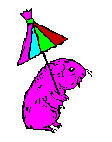 The Agoutis
The Agoutis
The agouti guinea pigs have short, silky hair that is "ticked" throughout the coat, which gives them a "shimmering"
effect. This is the pattern of the guinea pigs' wild ancestors. Various colors are bred:
 Silver. Dark undercolor
with silver ticking.
Silver. Dark undercolor
with silver ticking.
 Golden. Golden undercolor
with dark ticking.
Golden. Golden undercolor
with dark ticking.
 Cinnamon. Cinnamon with
silver ticking.
Cinnamon. Cinnamon with
silver ticking.
 Chocolate. Cinnamon with
a light ticking.
Chocolate. Cinnamon with
a light ticking.
 The Himalyan
The Himalyan
The Himalayan guinea pig has a white, silky coat with black or chocolate ears and feet. The nose is also black or chocolate, and is often times referred to as the "smut". The points on the Himalyan guinea are not as pronounced as they are on the Himilayan rabbit. The eyes are red.
The Himilayan breed can not be easily identified at birth. Himilayan young are born all-white, and are easily mistaken as Self Whites. Their markings gradually appear over the first few months after birth.
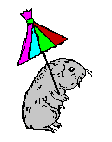 The Dutch
The Dutch
The Dutch are difficult to breed
to show quality. Their bodies are a Self or Agouti coloring with a white
"saddle" across the back and around to the belly. There is also a white
"blaze" running from the forehead down to the nose, where it meets with
the white belly coming up the neck. The ears should match the body color,
and not be flesh-toned.
The Dutch also have white foot-stops.
 The Dalmation
The Dalmation
As the name implies, the Dalmation
guinea pig has a white body with black spotting well distributed across
the animal. The head has a white blaze, and is black on either side. The
eyes are generally a deep ruby that may appear black in dim light. The
ears and feet are black.
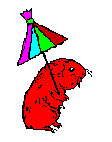 The Roan
The Roan
The Roan guinea pig has a black
body with an even mixing of white hairs throughout. Only the head and feet
have solid black hairs. Both the ears and the eyes are black. Some Roans
are also bred in colors, such as red and white, and red and black and white.
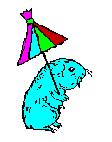 The Tortoiseshell
The Tortoiseshell
Tortoiseshell, and Tortoiseshell
and White The Tortoiseshell is also a difficult variety to breed to show
quality. The ideal markings consist of well-defined red and black patches
that are evenly spaced and uniformly distributed across the body. The Toroiseshell
and White cavy ideally has square cut patches in Red, Black and White on
the body. The dividing line between the four patches should run down the
middle of the back and across the middle of the belly with colors alternating
on each side of the division.
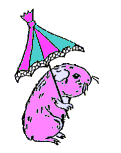 The Abbyssinian
The Abbyssinian
Commonly called an "Aby," it is one of the oldest recorded breeds. The Aby arrived in England in 1861. The Aby has a short, harsh coat that should display an even pattern of rosettes and ridges The coat is hard to brush, because the hair goes in many directions at once. Care should be taken to keep the coat clean and free of dirt.
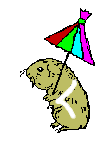 Sheltie
Sheltie
The coat of the Silkie should
be soft, dense, and have no evidence of any rosettes or forelock. The hair
should grow back from the face forming a mane. The mane sweeps from between
the ears to flow over the shoulders and back. There should be no part in
the mane. The side sweeps may be slightly shorter than the rear sweep.
When viewed from above, the Silkie presents a "teardrop" shape This is
a particularly cuddly pig, besides the softness of the coat, the personality
tends to be very mellow, making for a wonderful lap pig!
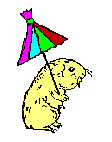 Texel
Texel
This is a very difficult breed
to care for. Not only is the hair long, but it has a wave in it you have
to be concerned that you do not hurt the animal when you're brushing its
coat! Cavy skin is very sensitive, they do not like it if their coats are
pulled in any way.
 English Crested.
English Crested.
Some guinea pigs have a special
hair crown on the top of their heads. This is called a crest.
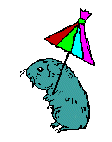 Rex
Rex
Rex guinea pigs have short,
thick hair. Their wavy coats feel coarse when you stroke them. They have
curly whiskers like the rex cat. They are the gentle giant of the guinea
pigs.
 Peruvians.
Peruvians.
Peruvian guinea pigs have silky
hair that grows down to the ground. The fringe must be brushed back to
stop it covering the eyes.
 Satins.
Satins.
Some guinea pigs have very soft
and shiny fur. These are called satins. The hair shaft is hollow and light
is reflected inside and outside of the hair, this makes them �glow�.
 Brindle:
Brindle:
Regular distribution of small
flecks in red and black, with dark eyes.
Please come back soon and visit me.

 � 1998 1999
� 1998 1999
Free Home Page